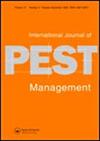金龟子绿僵菌和球孢白僵菌防治非洲稻瘿蚊的效果研究他赢
IF 1.1
4区 农林科学
Q3 ENTOMOLOGY
引用次数: 0
摘要
摘要非洲稻瘿蚊(Orseolia oryzivora,双翅目:瘿蚊科)是旱作水稻和低地水稻的重要害虫,可造成25% ~ 100%的产量损失。由于杀虫剂抗药性和对其环境影响的担忧,化学杀虫剂的有效性已经受到损害,因此需要一种更安全、更可持续的替代方法。本研究旨在确定昆虫病原真菌(EPF)、绿僵菌(Metarhizium anisopliae)和球孢白僵菌(Beauveria bassiana)在尼日利亚伊巴丹的AfricaRice/IITA筛选条件下对4种常用水稻品种的防治效果。试验采用完全随机设计(CRD),采用4 × 3因子拟合,共3次重复。结果表明,虽然两种真菌均能显著减少AfRGM分蘖侵染,但减少程度因真菌和水稻品种而异。AfRGM对FARO 37和FARO 44的抑菌效果较好,对FARO 66和FARO 67的抑菌效果较好。分蘖侵染与籽粒产量呈显著负相关(r= - 0.87, R2 = 77)。研究还表明,这两种真菌对叶绿素含量没有有害影响,对农艺性状和籽粒产量有积极影响。作者感谢Douro Kpindou博士提供的来自贝宁共和国IITA实验室的EPF分离株和Adebayo Kehinde先生的技术支持。披露声明作者未报告潜在的利益冲突。数据可用性声明数据可应要求提供。本文章由计算机程序翻译,如有差异,请以英文原文为准。
Efficacy of metarhizium anisopliae and beauveria bassiana as biological control agents of African Rice Gall Midge (AfRGM), Orseolia oryzivora Harris & Gagné
AbstractAfrican rice gall midge (AfRGM), Orseolia oryzivora (Diptera: Cecidomyiidae) is a significant pest of rainfed and lowland rice that causes about 25% to 100% yield loss. The effectiveness of chemical insecticides has been compromised due to insecticide resistance and concerns over their environmental impact, which necessitated an alternative approach that is safe and more sustainable. The study aimed to determine the effectiveness of Entomopathogenic fungi (EPF), Metarhizium anisopliae and Beauveria bassiana in controlling AfRGM on four popular rice cultivars under screenhouse conditions at AfricaRice/IITA, Ibadan, Nigeria. The experiment was laid out in a 4 x 3 factorial fitted in a completely randomized design (CRD) in three replications. Results showed that although both fungi significantly reduced AfRGM tiller infestation, the degree of reduction varied with the specific fungus and rice variety grown. Beauveria bassiana exhibited better control of AfRGM on FARO 37 and FARO 44 varieties, while M. anisopliae was more effective on FARO 66 and FARO 67 varieties. Tiller infestation had a significant negative correlation with grain yield (r= − 0.87, R2 = 77). The study also indicated that the two fungi strains had no harmful effect on the chlorophyll content and positively influenced agronomic traits and grain yield.Keywords: Entomopathogenic fungiMetarhizium anisopliaeBeauvaria bassianaAfRGMricetiller infestation AcknowledgementsThe authors gratefully appreciate Dr Douro Kpindou for providing the EPF isolates from IITA laboratory, Benin Republic and Mr. Adebayo Kehinde for technical assistance.Disclosure statementNo potential conflict of interest was reported by the author(s).Data availability statementData will be made available on request.
求助全文
通过发布文献求助,成功后即可免费获取论文全文。
去求助
来源期刊
CiteScore
4.70
自引率
6.70%
发文量
74
审稿时长
>12 weeks
期刊介绍:
International Journal of Pest Management publishes original research papers and reviews concerned with pest management in the broad sense, covering the control of pests (invertebrates, vertebrates and weeds) and diseases of plants, fungi and their products – including biological control, varietal and cultural control, chemical controland interference methods.
The management of invasive species is of special interest. We also encourage submissions dealing with interactions of multiple pests such as arthropods and plant pathogens, pathogens and weeds or weeds and arthropods as well as those dealing with the indirect and direct effects of climate change on sustainable agricultural practices.

 求助内容:
求助内容: 应助结果提醒方式:
应助结果提醒方式:


